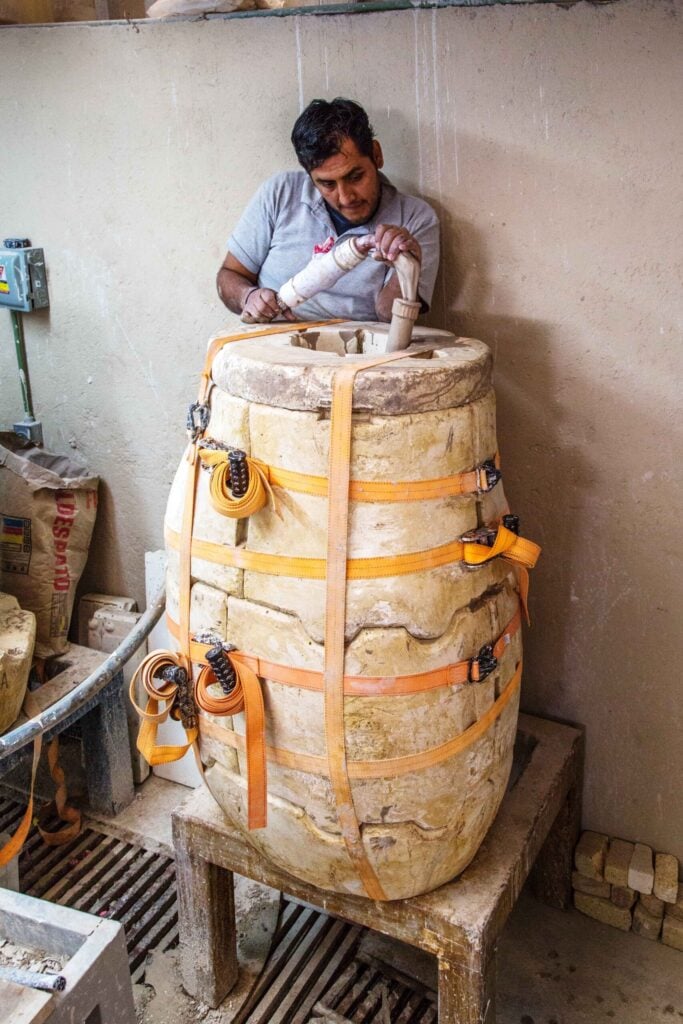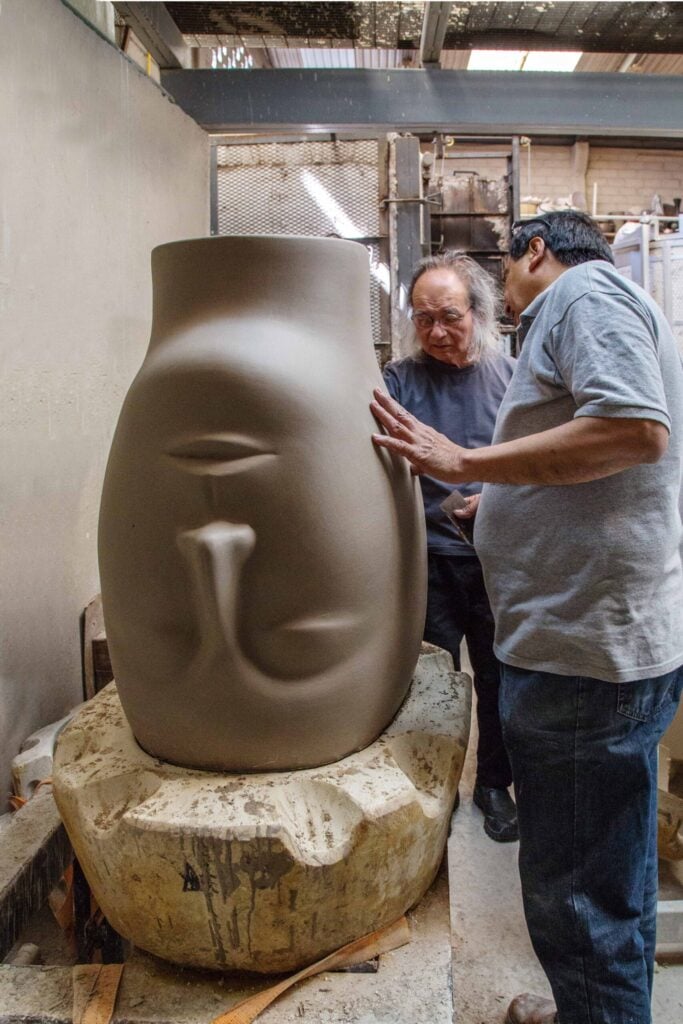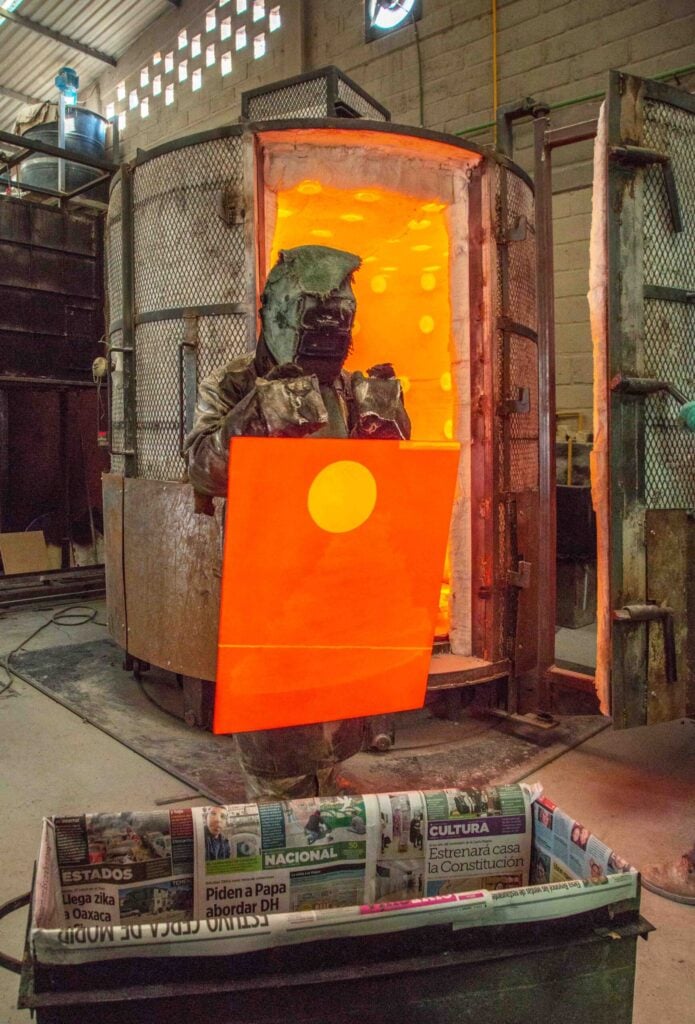Jun Kaneko first began experimenting with raku as a graduate student with Paul Soldner. However, as he became increasingly focused on large scale ceramics, he found the small kilns used for raku limited the execution of his ideas. Kaneko therefore abandoned raku firing until 2012, when he met ceramicist Juan de Dios Sanchez in Mexico. Sanchez operated a raku studio in Cuernavaca that specialized in the firing of large scale vessels. His passion for raku caught Kaneko’s interest, and they began to collaborate.
The theatrics of raku proved even more impressive with scale. Kaneko’s hand-glazed pieces were wheeled out of the firing kiln, glowing red hot, and locked into a box of combustibles. Flames surged out of the box, turning into thick smoke as the oxygen burned out. The resulting surfaces featured rich, smoky blacks, crackled glazes, and lustrous metallics. Paired with the large scale of Kaneko’s forms, the raku technique produced especially dramatic, unique works.

Trate Arte/Arte Kuan Studio
Cuernavaca, Mexico
Photo: Ree Kaneko

Removing plaster molds from a cast Tanuki.
2015
Trate Arte/Arte Kuan Studio, Cuernavaca, Mexico.
Photo: Takashi Hatakeyama

Plaster molds on a cast Tanuki
2015
Trate Arte/Arte Kuan Studio, Cuernavaca, Mexico.
Photo: Takashi Hatakeyama

Tanukis in various stages of completion.
Trate Arte/Arte Kuan Studio, Cuernavaca, Mexico.
Photo: Takashi Hatakeyama

Filling a slip cast form for a Head.
2015
Trate Arte/Arte Kuan Studio, Cuernavaca, Mexico.
Photo: Takashi Hatakeyama

Examining a Head cast Head.
2015
Trate Arte/Arte Kuan Studio, Cuernavaca, Mexico.
Photo: Takashi Hatakeyama

Jun works on designs for Heads in his sketchbook.
2016
Photo: Takashi Hatakeyama

Design sketches and notes for raku Heads.
2016
Photo: Takashi Hatakeyama

Jun applies glaze to a Wall Slab.
2016
Photo: Takashi Hatakeyama

Jun, Juan Sanchez and assistants with a head glazed in yellow.
2016
Photo: Takashi Hatakeyama

Jun applies yellow glaze to a Head.
2016
Photo: Takashi Hatakeyama

Jun and assistants glazing three Tanukis.
2016
Photo: Takashi Hatakeyama

Studio view with Jun working on a Head.
2016
Photo: Takashi Hatakeyama

A Tanuki is removed from the kiln while still red-hot.
Photo: Takashi Hatakeyama

A Head is removed from the kiln while still red-hot.
Photo: Takashi Hatakeyama

A Wall Slab is removed from the kiln while still red-hot.
Photo: Takashi Hatakeyama

Wall Slab being placed in reduction chamber, lined with newspapers.
Photo: Takashi Hatakeyama

The Wall Slab is then placed in a reduction chamber, which ignites upon contact.
Photo: Takashi Hatakeyama

Heads are placed in an enclosed reduction chamber, lined with combustibles. When the hot ceramic enters, the combustibles inside catch fire, causing the oxygen within to be consumed. This blackens the raw clay and causes a network of fine cracks, known as crazing, in the glaze surface.
Photo: Takashi Hatakeyama

Assistants begin to lower the reduction chamber, lined with newspapers above a Head immediately after removing it from the kiln.
Photo: Takashi Hatakeyama

A reduction chamber closes with a red-hot ceramic inside, flames shoot out the bottom.
Photo: Takashi Hatakeyama

Flames dance at the base of a raku reduction chamber.
Photo: Takashi Hatakeyama